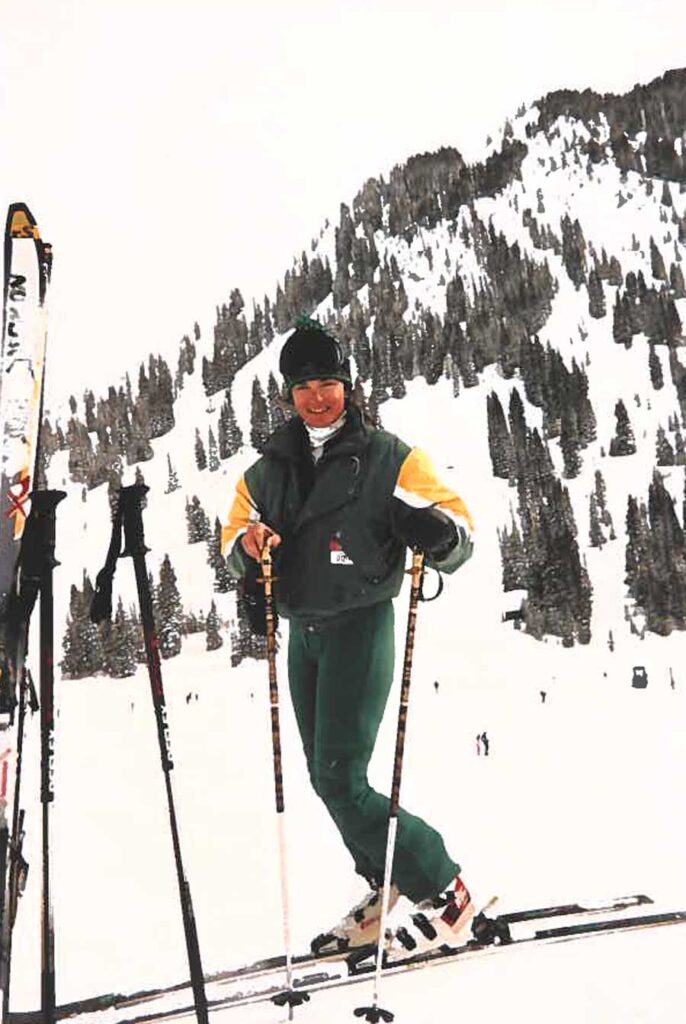Twenty-three ski instructors – eight of them female – formed the inaugural department when Deer Valley Resort opened in December 1981. Letitia Lussier was one of them and she remains an active instructor, the only one left from that cohort. Her remembrances follow.
A native of Maine, Lussier learned to ski at Lost Valley in her hometown of Auburn. In contrast to Deer Valley’s expanses, the ski area had two chairlifts, 65 acres of skiable terrain, and 240 feet in vertical drop. But it was a busy place. “Lost Valley had an active ski school and gave the highest number of lessons in the state,” she says. “It was a good place to learn.”
Her first ski industry job was as an instructor at Sunday River in Newry, Maine. “It was not very organized, and there was not much training for instructors,” she says. “If you skied well enough, they figured you could handle it.”
After two years at Sunday River, the lure of bigger hills and better snow sent her west. She taught at Alpental in Washington State for two years. “Alpental had a strong education program. I got my PSIA [Professional Ski Instructors of America] Level II certification there.”
Wanderlust called again and Lussier moved to Utah. “There may have been a boyfriend in the mix too,” she says wryly.
Her female peers at Deer Valley in that inaugural group included Mona English (wife of former VP of Mountain Operations Chuck English), Marion Wheaton (wife of former president and CEO Bob Wheaton), Kim Pratt, Dori Pratt, Donna Barnes, Karen McClain, and Linda Pierce.
Lussier remembers the first day Deer Valley opened. “The department had to stand in line, military style, at the start of the day. That lasted one morning.”
Nonetheless, at the time, she perceived what’s now called the Deer Valley Difference. “It was exciting to be part of something bigger. I’d never seen anything like it. The Sterns’ and our management had high expectations and were very well organized.”
Edgar and Polly Stern in particular were able to convey their high standards with a gracious and welcoming style when interacting with staff, Lussier says.
Those early days were long. “We were busier than expected. Often, we worked lessons all day with no lunch breaks. Sal Raio [ski school director] and John Guay would hand us granola bars to eat on the lifts. The second season, we were able to get regular lunch breaks!”
At the time, more of the male instructors had higher PSIA certification than the female ones. “The resort tended to assign the female instructors with more of the kids lessons. It was a lot of work.”

Credit: Courtesy of Letitia Lussier.
Children’s classes could have up to 14 students, she recalls, and in 1981, Deer Valley was comprised of Bald Eagle and Bald Mountains, roughly a third of the resort’s size today. “Success and Wide West didn’t give you a lot of terrain to work with.”
The attitudes in town were also a challenge. “The locals were a bit prejudiced against Deer Valley at the start. The resort was coming in with this high-end image. They called it Bambi Basin, and I’d get hoity toity, snide remarks when I said I worked there.”
Lussier does have fond memories of those early days. “We were a small crew, and very tight. We used to party a lot, and I don’t know how I survived! The skiing was fantastic…a lot of snow all the time.”
Lussier holds a degree in Fine Arts from the University of Utah and in education from Prescott College in Arizona. “I put myself through college working at Deer Valley. A lot of my paintings are of Deer Valley scenery.”
Looking back over the decades, Lussier is glad she came aboard and for her continued work at Deer Valley. “I learned to ski powder and got my Level III certification there. As for the department these days, we’re up above 500 instructors, and training is excellent, as is morale. It’s been a wonderful experience.”
Beside her passions for art and instructing, Lussier has been instrumental in Utah Mountain Bluebird Trails, a local conservation project that she started in 1995 to help declining native mountain bluebird populations. Lussier has installed and trained volunteers to monitor some 70 nesting boxes located around the county.
“During the mining days, when our slopes were clearcut of timber, we lost a lot of habitat for ‘cavity nesters’ like bluebirds and tree swallows. The project is an attempt to help these birds come back in healthy numbers.”
The Park City Museum is hosting a lecture at their Education and Collections Center at 2079 Sidewinder Drive on Wednesday, February 28 on Park City trains stuck in the snow and working through the snow from 5 to 6 p.m.